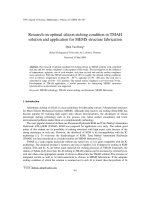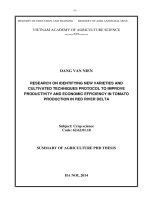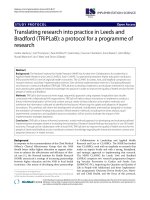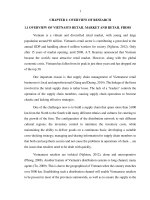Summary of Doctor of Medicine thesis: Research on multi-sequence computerized tomography values in diagnosis and results of laparoscopic surgery for radical treatment of rectal cancer
Bạn đang xem bản rút gọn của tài liệu. Xem và tải ngay bản đầy đủ của tài liệu tại đây (579.21 KB, 28 trang )
INTRODUCTION
Rectal cancer is a common cancer of the digestive tract, a common
disease in the world, especially in developed countries. According to
the World Health Organization (2003), it is estimated that each year,
around 572,100 people have colorectal cancer (in which colorectal
cancer accounts for the most rate). In Vietnam, the rectal cancer is
ranked the fifth after the bronchial, stomach, liver, and breast cancers.
As noted by the Hanoi Cancer Society (2002), nearly 15,000 new cases
are diagnosed each year with the rate of 13.1/100000 people and about
7000 deaths.
To achieve high effectiveness in the treatment, computerized
tomography, magnetic resonance imaging have been used to diagnose
the disease and the level of organ invasion, lymph node metastasis in
rectal cancer. Although MRI is increasingly proving superiority,
multidisciplinary computed tomography is still valuable in the diagnosis
of rectal cancer, especially for the diagnosis of distant metastases, as
well as the popularity of medical facilities. local, easy to carry, time
taken. Thus, the strategy of treating rectal cancer for each patient is
formulated more completely and accurately, with higher treatment
efficiency. In the treatment of rectal cancer, surgery plays an important
role, other treatments such as radiation and immunochemicals have an
auxiliary role. Radical surgery in the treatment of rectal cancer is the
destination of all surgeons in the treatment of cancer in general and
rectal cancer in particular. Radical surgery can be done with classic
open surgery or laparoscopic surgery. In order to contribute to
perfecting the method of diagnosis and treatment of rectal cancer, we
have conducted research on this topic with two objectives:
1. Determining the values of multithreaded computer tomography in
the diagnosis of rectal cancer.
2. Evaluating the results of radical laparoscopic surgery treatment of
rectal cancer.
1. New contributions of the thesis
The dissertation has gained new results and contributed more to the
specialization.
Indicates the diagnostic value of multithreaded computer
tomography with rectal cancer. In particular, the degree of invasive
diagnosis has an accuracy of 88.197.4% with sensitivity of 2095.8%,
specificity of 80.0100%. Diagnosis of lymph node metastasis has the
accuracy of 63.576.2%, sensitivity of 48.7100%, specificity of 67.5
94.7%. Diagnosis of the disease stage has the accuracy of 63.598.3%.
Reporting the results of laparoscopic surgery for radical treatment
of rectal cancer applied at Viet Duc University Hospital: No death after
surgery, early complications after surgery 8.5%, average hospitalization
time 8.4 ± 3.5 days. Recurrence rate of 15%, death of 9.3% (after 247
months)
The followup results showed that the overall survival rate was
43.8 months, the average without disease was an average of 42.5
months. The sequelae of sexual disorders are 14.0%. The thesis also
analyzes in depth the relationship between the degree of damage of
rectal cancer and the extra time after surgery. Which has determined the
extent of invasive tumor is an independent prognostic factor of the extra
lifetime.
The thesis has contributed to further clarify the diagnostic value of
rectal cancer lesions of multithreaded computer tomography and the
results of radical laparoscopic surgery treatment of rectal cancer.
2. The thesis structure
The thesis consists of 138 pages, including: Introduction (2 pages);
Chapter 1: Literature Overview (36 pages); Chapter 2: Research subjects
and methods (20 pages); Chapter 3: Results (42 pages); Chapter 4:
Discussion (36 pages); Conclusion: (2 pages), The thesis has 50 data
tables, 20 charts; 13 photos; 122 references (46 Vietnamese documents,
76 English documents), appendices, research form, patient list.
CHAPTER 1. LITERATURE OVERVIEW
1.4. CT ANATOMICAL CHARACTERISTICS OF RECTUM
AND PELVIS
For computerized rectal tomography, the patient is cleared of stool
with enemas or indented 11.5 liters of fluid into the colorectal. Helical
technique from diaphragm arch to edge of anus with thin cutting
thickness on axial, reconstructed on two (sagital) and horizontal
(coronal) planes.
1.4.1. Rectal position and structure
* Rectal position: On the sagial plane it is possible to locate the
rectum by measuring the distance from the anus. Rectal 1/3 section on
anal margin 1015cm, 1/3 median between anal margin 5 10cm, low
segment 5cm anal margin. On the horizontal plane (axial), the rectum
looks like a round tube with a diameter of 35cm. The wall of the
rectum is about 36 mm thick.
* Structure of rectal walls: Rectal wall consists of 4 layers. On
computerized tomography, the layers of the rectum wall are
indistinguishable.
1.4.2. Related topographical anatomy
Rectal balls are covered partially by peritoneal, on the front and
two sides with the related parts: front, back, side.
* On a horizontal plane (axial):
Between men and women have similar or different images
depending on the location of computer tomography, in men with
seminal vesicles, prostate, In women with uterus, vagina. There are 3
basic cutting positions.
Low slice through the anal canal
1/3 middle slice
Upper 1/3 slice, the same for both men and women
1.5. SURGICAL TREATMENT OF RECTAL CANCER
Surgery is the main treatment for rectal cancer.
1.5.3. Endoscopic surgery to treat rectal cancer
In 1990, Moises Jacob was the first one who applied the
laparoscopic cancer surgery. The oncological research results show that
laparoscopic surgery has the ability to cut and remove lymph nodes
horizontally with open surgery.
Indications for laparoscopic surgery for rectal cancer are not
limited with age but need to fully evaluate respiratory and circulatory
function. Location and number of trocar: 46 trocar depending on the
habits of the surgeon. The amount of blood lost during surgery ranges
from 30 60ml. The overall complication rate is 5 18%.
The rate of complications in laparoscopic surgery is lower than that
of open surgery confirming the feasibility of laparoscopic surgery.
Postoperative results between hand and machine connection showed no
difference in complications or deaths.
1.6. SITUATION OF LAPAROSCOPIC SURGERY FOR RECTAL
CANCER TREATMENT IN THE WORLD AND IN VIETNAM
1.6.1. In the world
In the world, there have been many studies on laparoscopic rectal
cancer surgery compared and compared with open surgery for many
good results. Zhou G. et al. (2004) compared rectal cancer patients
undergoing laparoscopic surgery (82 patients) and open surgery (89
patients) found that laparoscopic surgery had the amount of blood loss
(20 ml: 5–120 ml) less than open surgery (92 ml: 50–200ml), p <0.05.
Wang YW et al (2015) paired analysis (laparoscopic surgery of 106
patients; open surgery: 106 patients) found the surgery time (180.8 ±
47.8 minutes compared to 172.1 ± 49, 2 minutes), the number of
removable lymph nodes (12.9 ± 6.9 compared to 12.9 ± 5.4) and
postoperative pathological characteristics of the two groups were not
statistically significant ( p> 0.05). Baek JH et al. (2015) studied 230
patients with 5year diseasefree survival time of rectal cancer patients
83% (laparoscopic surgery) and 74.6% (open surgery), ( p> 0.05).
1.6.2. In Vietnam
In Vietnam, laparoscopic surgery has been used since 1992 at Cho
Ray Hospital. Currently, rectal cancer laparoscopic surgery has been
carried out in many hospitals such as Viet Duc University Hospital,
National Cancer Hospital, Military Hospital 103, Hue Central
Hospital ...
Nguyen Hoang Bac et al. (2010) retrospectively examine 482 rectal
cancer surgery patients at Ho Chi Minh City University of Medicine
and Pharmacy Hospital to see 329 cases of rectal segmentectomy and 19
posterior colonoscopy. subject, 134 surgery Miles. There are 21 cases of
open surgery. Two patients had damage to the ureter, 22 patients (6%)
had a rectal fistula, and three patients had early bowel obstruction after
Miles surgery. Average hospitalization time of 6.9 days.
Pham Van Binh (2017) studied 53 patients on 1/3 of rectal cancer
who had surgery to cut the colorectal segment and connected the
machine, the average surgery time was 136.7 34.5 minutes (Internal
surgery soi 171.8 45.7 minutes; open surgery: 124 17.2 minutes).
The average hospitalization time after surgery is 10.2 2.6 days. The
total extra life of 3 years is 85.1%.
CHAPTER 2
RESEARCH SUBJECTS AND METHDS
2.1. RESEARCH SUBJECTS
Including rectal cancer patients who underwent radical
laparoscopic surgery at VietnamGermany Hospital from June 2013 to
June 2015.
2.1.1. Criteria for selecting patients
The patient was diagnosed with a lower rectal cancer tumors less
than 15cm from the edge of the anus.
Having an anatomical diagnosis of Adenocarcinoma disease.
Performing multithreaded computer tomography pelvic region.
Radical laparoscopic surgery for radical treatment at Viet Duc
University Hospital.
2.1.2. Exclusion criteria
patients refuse to cooperate, not to undergo laparoscopic surgery.
Patients should not receive pelvic region multithreaded computer
tomography. Cases of comorbidities such as heart failure, hypertension,
stroke, chronic asthma, bronchial asthma, uncontrolled or life
threatening diabetes.
Anal cancer, prostate colon cancer.
Temporary treatment of rectal cancer.
2.2. RESEARCH METHODS
2.2.1. Research design
Study design: prospective descriptive study, combined with
longitudinal comparison to monitor and evaluate results after
laparoscopic surgery.
2.2.2. Research variables
All information was collected by questionnaires through sample
cases, direct patient visits, multithreaded computer tomography, tumor
invasion assessment, GPB comparison and evaluation of surgical
results. including:
2.2.2.1. General characteristics of studied patients
Age, gender, occupation.
Serum CEA test
Colonoscopy by soft tube
2.2.2.2. Multithreaded computer tomography in rectal cancer
Using the 64reading computerized tomography machine Dawy
GE ligh speed including 2CPU and 4 screens of US origin.
Multithreaded computer tomography of pelvic region and
intravenous contrast injection to assess:
Evaluating tumor characteristics, including: tumor size, tumor
density according to the perimeter of the rectum (accounting for 1/2,
2/4, 3/4 and the circumference). Level of invasive tumor, assessment of
degree of pelvic and pelvic lymph node metastasis, evaluation of distant
metastasis, evaluation of stage of disease, assessment of invasive level
of rectal cancer on computerized tomography multisequence according
to the division of Thoeni in 2 stages: localized tumor in rectum wall,
invasive tumor.
2.2.2.3. Anatomy results after surgery
* Macrobody: Postoperative tumors were assessed for macrobody
lesions in terms of location, size, shape, and properties; Cut a slice at
the 2cm invasive position to assess the degree of rectal wall invasion.
Lymph nodes are analyzed for evaluation: location, size, number
of lymph nodes.
* Microbody: Tumors and lymphomas are read and analyzed by GPB
specialists.
2.2.2.4. Assess the stage of rectal cancer
* Classify TNM according to UICC 2010
2.2.2.5. Results in radical laparoscopic surgery of rectal cancer:
Surgical characteristics, operation time: in minutes. Accident
during surgery: Bleeding, vaginal perforation, ureteral damage, bladder.
posterior urethral lesion, blood transfusion during surgery.
2.2.2.6. Early results after laparoscopic radical surgery for rectal
cancer
Death after surgery. Complications after surgery: intra
abdominal bleeding; peritonitis; Postoperative urinary retention;
infection of the abdominal incision; infection of the episiotomy
incision; artificial anal prolapse, artificial anal lag; splitting of
abdominal wall; early bowel obstruction after surgery ... Time to
return to peristalsis, bladder sonde withdrawal time after surgery,
hospitalization time after surgery: in days.
2.2.2.7. Results after radical surgery rectal cancer
Periodic examination and monitoring, record the following
information:
Postoperative sequelae, the rate of local recurrence and metastases.
Evaluate sexual function after surgery
A number of factors affecting total and nonsurgical survival
time: age, gender, CEA before surgery, tumor size, degree of
differentiation of tumor cells, degree of invasion, metastasis
lymphadenopathy and the stage of the disease ...
2.2.3. Endoscopic surgical procedure
* Equipment: Complete for a laparoscopic surgery
* Preparation before surgery:
Preparation of colon before surgery
Anesthesia: intubation.
* Patient posture and position of surgeon
* The surgical stages
2.2.4. Data processing
Data were managed and analyzed by SPSS 22.0 software. The
difference was statistically significant between groups when p <0.05.
CHAPTER 3
RESEARCH RESULTS
3.1. SOME GENERAL CHARACTERISTICS OF RECTAL
CANCER PATIENTS
3.1.1. Age and gender
Table 3.1. Distribution by age and gender
Age
group
Male
Numbe
r of
Female
Rate Number
(%)
of
Total
Rate Number
(%)
of
Rate
(%)
≤40
41 50
51 60
61 70
>70
years
old
Total
± SD
patient
s
6
4
24
17
13
64
59.8
12.2
patients
patients
5.1
3.4
20.3
14.4
3
8
15
16
2.5
6.8
12.7
13.6
9
12
39
33
7.6
10.2
33.1
28.0
11.0
12
10.2
25
21.2
54.2
60.2
12.8
54
45.8
118
60.0 12.5
(26 86)
100.0
p>0.05
The average age of male patients (59.8 12.2 years) was not different
from female patients (60.2 12.8 years), p> 0.05.
Male account for 54.2%, female is 45.8%. The male to female ratio is
1.19.
3.1.4. Subclinical characteristics
Table 3.3 Cancer fetal antigen characteristics (CEA)
CEA concentration Number of patients
(ng/ml)
(n = 118)
Normal
89
High
29
(± SD)
Median (smallest largest)
Rate (%)
75.4
24.6
7.8 30.8
3.2 (0 330)
High serum CEA concentration in rectal cancer patients had
29/118 patients, accounting for 24.6%.
Average concentration of 7.8 ± 30.8 ng / ml.
3.1.5. Histological characteristics of rectal cancer
Table 3.6. Histopathological characteristics of rectal cancer
Histopathologi
Number of
cal
patients
Rate (%)
characteristics
Macrobody
(n= 118)
Microbody
(n= 118)
Degree of
differentiation
(n= 118)
Ulcers
Swells
Ulcerative swelling
Infiltrates
13
42
61
2
11.0
35.6
51.7
1.7
Adenocarcinoma
118
100
High
Moderate
Weak
19
87
16.1
73.7
12
10.2
Evaluation of macrobody showed that ulcerative body accounted
for the highest proportion (51.7%), followed by warts (35.6%) and
ulcers (11.0%). There is 1.7% of infiltrates.
Of the 118 patients with rectal carcinoma, the majority had
moderate degree of differentiation (73.7%), 16.1% with high grade and
10.2% with poor differentiation.
Table 3.7. Features of lymph node metastasis of rectal cancer
Đặc điểm di
căn hạch
Location of
lymph node
metastases
(n= 118)
Number of
lymph nodes
(n= 118)
(stage N)
Number of
patients
Zero
Around the rectum
In front of the
overhang
Inferior mesenteric
Zero (N0)
1 3 (N1)
≥4 (N2)
Rate (%)
80
22
67.8
18.6
3
2.5
13
80
28
11.0
67.8
23.7
10
8.5
Assessing lymph node status in surgery saw:
Number of lymph nodes: 67.8% of cases without lymph node
metastases (N0); 23.7% of cases metastases from 1 to 3 lymph nodes
(N1); only 8.5% of metastases ≥4 lymph nodes (N2).
Locations of lymph node metastasis: lymph nodes around the rectum
(18.6%), anterior lymph nodes (2.5%), mesenteric lymph nodes (11.0%).
Table 3.8. Stage of rectal cancer disease on anatomical pathology
AJCC
Stage 0
Stage I
Stage II
Stage
III
TNM
Dukes
TisN0M0
T1N0M0;
A
T2N0M0
IIa
T3N0M0
IIb
T4aN0M0
IIc
T4bN0M0
Subtotal
IIIa
T12N12aM0
T34aN1M0;
IIIb
T23N2aM0;
T12N2bM0
T4aN2aM0;
IIIc
T34N2bM0;
T4bN12M0
Subtotal
Number
of
patients
3
Rate
%
2.5
30
25.4
B
B
B
C
44
3
0
47
2
37.3
2.5
0
39.8
1.7
C
31
26.3
C
5
4.2
38
32.2
Anatomy of postoperative disease in 118 rectal cancer surgery
patients found:
According to TNM classification, stage 0 is 2.5%; Phase I is
25.4%; Phase II is 39.8% (IIa: 37.3% and IIb: 2.5%); Stage III is 32.2%
(IIIa is 1.7%; IIIb is 26.3%; IIIc is 4.2%). There are no cases of stage
IV.
Classified by Duckes: Dukes A period is 25.4%; Dukes B is 39.8%
and Dukes C is 32.2%.
3.2. RESULTS OF RECTAL CANCER DIAGNOSIS VIA
MULTITHREADED COMPUTER TOMOGRAPHY
3.2.1. Result of diagnosing the degree of invasion through
multithreading computer tomography
Table 3.10. Assess the extent of invasive rectal cancer through
computer tomography
Invasive
features on
computerized
tomography
Thick wall of
rectum (mm),
(± SD), median
(largest
smallest)
Tumor height
(mm), (± SD)
median (largest
smallest)
Number of
patients
(n = 118)
Rate
(%)
2.14 4.27
1.6 (0.1 45.0)
4.72 4.54
4 (0.2 47.0)
Difficult to assess
<1/4
1/4 – 1/2
1/2 – 3/4
>3/4
Tx: Difficult to evaluate
T1: In the wall (<6mm) or in
The degree of the intestine
invasion
T2: Wall thickness> 6mm
but has not invaded
surrounding tissue
T3: Wall thickening and
invading of surrounding
tissue
T4: Invading nearby organs
Tumor
circumferenc
e
2
9
28
45
34
1
1.7
7.6
23.7
38.1
28.8
0.8
5
4.2
22
18.6
86
72.9
4
3.4
On computerized tomography, the average thickness of rectal wall is
2.14 4.27mm; The height of the average tumor is 4.72 4.54mm.
The majority of patients have tumor size compared to the rectum
from 1/4 to 1/2 (23.7%), 1/2 to 3/4 (38.1%) and> 3/4 of the circumference
(28.8%); tumor size is less than 1/4 circumference and difficult to assess,
accounting for low percentage (7.6% and 1.7%).
The extent of tumor invasion (T): highest in T3 (72.9%), followed by
T2 (18.6%), T1 and T4 accounted for low rate (4.2% and 3.4 %). There is 1
case (0.8%) of T stage not identified.
Table 3.11. Compare the degree of invasive cancer of rectum
through computerized tomography with pathology
Stage T
Stage T
on
on
patholo
comput
gical
erized
surgery
tomogr
Total
aphy
(Numbe
r of
patients
,%)
Tis
Tx
1
100.0%
T1
2
40.0%
3
60.0%
T1
0
T2
0
0
T3
0
0
T2
T3
T4
0
0
0
0
0
9
10.5%
70
1
25.0%
1
1
4.5%
18
81.8%
2
3
2.5%
4
3.4%
28
23.7%
73
T4
Tổng số
0
0
1
100.0%
5
100.0%
9.1%
1
4.5%
22
100.0%
81.4%
7
8.1%
86
100.0%
25.0%
2
50.0%
4
100.0%
61.9%
10
8.5%
118
100.0%
Comparing the invasion of colorectal cancer through multithreaded
computer tomography with GPB found the highest proportion of
diagnosed matches in the Tx stage (1/1 patient), followed by T2 (81.8 %
%), T3 (81.4%), T1 (60.0%) and T4 (50.0%).
3.2.2. Diagnosis of lymph node metastasis through multithreaded
computer tomography
Table 3.14. Reconstructing lymph node metastases stage of rectal
cancer via multithreaded computer tomography with pathology
Stage N on
computeriz
ed
Stage N on
Total
pathological tomography
(Number of
surgery
patients,%)
N0
N1
N2
39
16
25
80
N0
50.0%
55.6%
67.8%
95.1%
16
2
10
28
N1
4.9%
22.2%
23.7%
50.0%
10
10
N2
0
0
8.5%
22.2%
41
32
45
118
Total
100.0%
100.0%
100.0%
100.0%
Comparing the lymph node metastatic stage of rectal cancer through
multithreaded computer tomography with pathology showed that the
incidence of computed tomography was highest at stage N0 (95.1%),
followed by N1 ( 50.0%) and N2 (22.2%).
3.2.3. Phase diagnosis results through computerized tomography
Table 3.16. Diagnosis of stage of rectal cancer on computerized
tomography
Number
of
Rate
AJCC
TNM
Dukes
patients
(%)
(n= 118)
Stage 0
TisN0M0
1
0.8
Stage I
T1N0M0;
A
18
15.3
T2N0M0
Stage
IIa
T3N0M0
B
21
17.8
II
Stage
III
IIb
IIc
Subtotal
IIIa
IIIb
IIIc
Subtotal
T4aN0M0
T4bN0M0
B
B
C
1
22
7
0.8
18.6
5.9
T12N12aM0
T34aN1M0;T2
3N2aM0;T12N2bM0
T4aN2aM0; T3
4N2bM0;T4bN12M0
C
67
56.8
C
3
2.5
77
65.3
On computerized tomography images of 118 rectal cancer patients:
Classification according to TNM: period 0 is 0.8%; Phase I is
15.3%; Phase II is 18.6%; Phase III is 65.3%. There were no cases of
distant metastasis (stage IV).
Classified by Duckes: Dukes A period is 15.3%; Dukes B is
18.6% and Dukes C is 65.3%.
Table 3.17. Reconstructing rectal cancer stage by multithreaded
computer tomography with pathology
Stage of
Stage of
Total
rectal
rectal
(n = 118)
cancer on cancer on
pathologi computed
cal
tomograp
surgery
hy
(Number
of
patients,
%)
Stage 0
Stage I
Stage II
Stage III
1
2
3
Stage 0
0
0
11.1%
2.5%
100.0%
16
1
13
30
Stage I
0
4.5%
16.9%
25.4%
88.9%
19
28
47
Stage II
0
0
36.4%
39.8%
86.4%
Stage III
0
0
Total
1
100.0%
18
100.0%
2
9.1%
22
100.0%
36
46.8%
77
100.0%
38
32.2%
118
100.0%
Comparison of diagnosis of stage rectal cancer through
multithreaded computer tomography with GPB found the highest
proportion of diagnosis matching in stage 0 (1/1 patient), followed by
stage I (88.9% ), Phase II (86.4%) and the lowest is Stage III (46.8%).
Table 3.18. Diagnostic value for rectal cancer stage according to AJCC
of multireaded computed tomography
Stage of
Stage of rectal cancer (AJCC) on pathological surgery
rectal
cancer
(AJCC) on
Stage 0 Stage I
Stage II
Stage III
computerize
d
tomography
Sensitivity (%)
33.3
53.3
40.4
94.7
Specificity (%)
100
97.7
95.7
48.7
Positive forecast value (%)
100
88.8
86.3
46.7
Negative forecast value (%)
1.7
14.0
29.1
4.8
Accuracy (%)
98.3
86.4
73.7
63.5
The sensitivity of diagnosis of rectal cancer stage of
multidisciplinary computed tomography ranges from 33.3% to 94.7%.
The specificity for diagnosing the stage of rectal cancer in multi
computed tomography ranges from 48.7% to 100%.
Positive predictive value in rectal cancer stage diagnosis of multi
computed tomography ranged from 46.7% to 100.0%.
Negative predictive value in rectal cancer stage diagnosis of
multidisciplinary computed tomography ranged from 1.7% to 29.1%.
The accuracy in diagnosing rectal cancer stage of multithreading
computer tomography ranges from 63.5% to 98.3%.
3.3. LAPAROSCOPIC SURGERY METHOD OF RADICAL
TREATMENT OF RECTAL CANCER
3.3.2. Surgical time
Table 3.22. Time for laparoscopic surgery to treat rectal cancer
Cut the
rectum
and
Miles
Total
connect surgery
(n= 118)
Surgica immedi (n= 37)
ately
l time
(minute (n= 81)
s)
Number
Numbe
Number
of
Rate
r of
Rate
of
Rate
patient
(%)
patient
(%)
patient
(%)
s
s
s
<150
20
24.7
5
13.5
25
21.2
≥150
61
75.3
32
86.5
93
78.8
± SD
170.0
174.6
171.4 38.6
42.1
30.0
(82 330)
p
p>0.05
The average laparoscopic surgery time is 171.4 ± 38.6 minutes
(the shortest: 82 minutes; the longest: 330 minutes). The majority of
patients had surgery time ≥150 minutes (78.8%).
The average laparoscopic surgery time in the immediate rectal
segmentation group (170.0 42.1 minutes) was not different from the
Miles surgery group (174.6 30.0 minutes), p> 0.05
Table 3.26. Time of hospitalization after surgery
Time of Cut the
hospita rectum
lization
and
Miles
Total
after connect surgery
(n= 118)
surgery immedi (n= 37)
(day)
ately
(n= 81)
Numbe
Rate Number Rate Number Rate
r of
(%)
of
(%)
of
(%)
patient
patients
patients
<7
≥7
± SD
p
s
6
75
8.7
3.9
7.4
92.6
7.7
2.3
4
33
10.8
10
89.2
108
8.4 3.5
(5 35)
8.5
91.5
p>0.05
Average hospitalization time after surgery: 8.4 ± 3.5 days (shortest:
5 days and longest: 35 days). Most patients had a hospital stay of ≥7
days after surgery (91.5%).
The postoperative hospital stay in the Miles surgical group (7.7
2.3 days) tended to be shorter than the immediate rectal incision (8.7
3.9 days), but the difference No statistical significance (p> 0.05).
3.5. DISTANT RESULTS AFTER RADICAL LAPAROSCOPIC
TREATMENT OF RECTAL CANCER
107/118 patients (90.7%) were monitored after surgery with an
average time of 29.3 8.3 months (2 47 months)
3.5.1. Sequelae, recurrence and death after surgery
Table 3.28. Recurrence and death rates after surgery in patients with
rectal cancer
Number of
Death,
Rate
Time
patients
recurrence
(%)
(± SD) [median]
(n= 107)
23.3 ± 11.4 (1 36)
Death
10
9.3
[median: 25.0]
26.0 ± 9.8 (7.0 47.0)
Recurrence
16
15.0
[median: 25.5]
The recurrence rate is 15.0%. The average relapse time was 26.0
9.8 months (7 47 months) [median: 25.5 months].
The death rate is 9.3%. The average time of death was 23.3 ± 11.4
months (136 months) [median: 25.0 months]
3.5.2. Complete survival time and diseasefree survival
Table 3.29. Complete survival time of rectal cancer patients
Complete survival
Number of died
Rate (%)
time (month)
12
24
36
±SE (KTC 95%)
patients
(±SE)
(n= 10)
2
98.1 1.3
5
94.9 2.2
10
83.7 5.5
43.8 0.9 (KTC 95%: 42.0 45.7)
The overall survival rate of 12, 24 and 36 months was 98.1%; 94.9%
and 83.7%. The average overall survival time was 43.8 0.9 months (95%
CI: 42.0 45.7).
Figure 3.1. Complete survival time of rectal cancer patients
Table 3.30. Diseasefree survival time of rectal cancer patients
Diseasefree
survival time
(month)
12
24
36
47
±SE (KTC 95%)
Number of relapsed
Rate (%)
patients
(±SE)
(n = 16)
2
98.1 1.3
6
93.8 2.4
15
76.9 6.0
16
42.5 1.0 (KTC 95%: 40.3 44.6)
The rate of survival without disease 12, 24 and 36 months was
98.1%; 93.8% and 76.9%. The median nondisease survival time was
42.5 1.0 (95% CI: 40.344.6)
Figure 3.2. Diseasefree survival time of rectal cancer patient
CHAPTER 4
DISCUSSION
4.1. CHARACTERISTICS OF STUDIED SUBJECTS
4.1.1. Age
Rectal cancer is increasing, usually after 40 years of age and
increases most in the age group of 5070 years. Through research, the
average age of patients is 60.0 ± 12.5 years old. (2686 years old). The
mean age of male patients (59.8±12.2 years) was not different from
female patients (60.2 ±12.8 years), p> 0.05.
4.1.2. Gender
The majority of studies show that the proportion of rectal cancer
patients is male than female. Male patients have a harder time predicting
surgery than female patients due to the narrower pelvic anatomy.
The research results show that men account for 54.2%, women are
45.8%. The male to female ratio is 1.19. This is also consistent with
some studies on the sex of rectal cancer patients.
4.1.3. Distribution of patients by geography
Research shows that patients in rural areas still account for the majority
(79.7%), including some remote provinces such as Lai Chau, Cao Bang and
Dien Bien. This result is similar to that of Pham Van Binh researched at
National Cancer Hospital (2012), 72.59% of rural patients.
4.2. CLINICAL AND SUBCLINICAL CHARACTERISTICS OF
RECTAL CANCER
4.2.2. Subclinical characteristics of rectal cancer
4.2.2.1. Cancer fetal antigen characteristics (CEA)
Many studies show that CEA levels increase over 60% of patients
with colorectal cancer, especially rising 80% to 100% in the advanced
stage, especially when there is distant metastases in the liver, lungs ...
According to Duong Xuan Loc et al. (2011), the majority of patients
with CEA cancer marker increased above 10 ng /ml (72.2%) and
CA19.9 increased over 37 ng / ml by 15.6%. .
The study showed that the average CEA concentration of rectal
cancer patients was 7.8 ± 30.8 ng / ml. High serum CEA levels in rectal
cancer patients had 29/118 patients, accounting for 24.6%.
This is also consistent with the comment of Trinh Hong Son (2011)
40.7% of patients with high CEA; 88% of CEA cases> 5 ng / ml are
stage T3 and T4 cancers. The CEA rate increased among the very
differentiated, moderate and inferioriated groups, respectively, by
30.8%; 42.9%; 51.2%, the difference is statistically significant with p <0.05.
However, all studies agree that the CEA test is not sensitive
enough and specific enough to be used in rectal cancer screening, but
that it is most significant in the prognosis for monitoring local
recurrence and distant metastases after surgery.
4.2.3. Histological characteristics of rectal cancer
Study on tumor characteristics in surgery with moderate
differentiation (74.8%), 15.7% in highgrade cases and 9.6% in low
grade cases. According to TNM classification, stage 0 is 2.5%; Phase I is
25.4%; Phase II is 39.8%; Phase III is 32.2%. There are no cases of stage IV.
Results of Vo Quoc Hung (2013) showed that: adenocarcinoma:
87.4%; Mucous adenocarcinoma: 6.3%; squamous cell carcinoma:
5.4%; Ring cell adenocarcinoma: 0.9%. Ung Van Viet (2017) studied
227 rectal cancer patients who found that most cases (78.4%) had tumor
differentiation as average. There are 3.1% of cases with poor
differentiation.
4.3. VALUES OF MULTITHREADED COMPUTER
TOMOGRAPHY IN THE DIAGNOSIS OF RECTAL CANCER
Multithreaded computer tomography helps to assess the condition
of the tumor (location, size, distance from the anus edge, invasion of the
superior mesenteric weight, lymph node metastasis ...). In addition, it is
also possible to assess the distant metastasis status without the need for
additional film.
4.3.1. Multithreaded computer tomography values in the diagnosis
of invasive degree
Computerized tomography does not have the ability to describe
rectal anatomical layers, so the accuracy of computed tomography in
assessing tumor invasion with the wall of the rectum varies from 25 %
to 80%. Li XT et al. (2016) analyzed 9 studies on computerized
tomography in 407 patients with rectal cancer found that sensitivity and
specificity in T stage diagnosis were 89% (95% CI: 77% 95%) and
80% (95% CI: 72% 86%).
Assessing the extent of tumor invasion on computerized
tomography according to Thoeni found the most in T3 (72.9%),
followed by T2 (18.6%), T1 and T4 accounted for a low rate (4.2) %
and 3,4%). There was 1 case (0.8%) without determination of stage T.
Evaluation of multithreaded computer tomography in diagnosis of
invasive level (T1, T2, T3 and T4) found the sensitivity ranged from
70.0 % to 95.8%. Specificity ranges from 80.0% to 100.0%. Accuracy
ranges from 88.1% to 97.4%.
The sensitivity, specificity, and accuracy of computed tomography
in the diagnosis of rectal cancer invasion in our study are similar to
those of other authors.
4.3.2. Multithreaded computer tomography values in the diagnosis
of lymph node metastases
Nstage assessment described lymph node with diameter> 10 mm
is considered abnormal. Computerized tomography cannot distinguish
benign or malignant lymph nodes. Moreover, malignant ganglia may be
diameter <10 mm. 60% of lymph nodes are detected by computerized
tomography.
Evaluation of multithreaded computer tomography values in the
diagnosis of lymph node metastases of rectal cancer showed that the
sensitivity ranged from 48.7% to 100.0%. Specificity ranges from
67.5% to 94.7%. The accuracy ranges from 63.5% to 76.2%.
According to Dar R. A study, the sensitivity in diagnosing lymph
node metastasis is 77%, specificity 87%, accuracy is 84.1%.
4.3.4. The value of multithreading computer tomography in stage
diagnosis
The value of multithreaded computer tomography in the diagnosis of
rectal cancer stage in our study (sensitivity ranges from 33.3% to 94.7%;
specificity ranges from 48.7% to 100% The accuracy ranges from 63.5% to
98.3%). 86%, stage N was 84% and the upper mesenteric metastasis was
predicted to be 94.5%.
4.4. RESULTS OF RADICAL SURGICAL TREATMENT OF
RECTAL CANCER
4.4.1. Surgical method
Research shows that radical laparoscopic surgery for rectal cancer
mainly cuts the rectum immediately connected (68.6%), 31.4% of cases
for rectal resection and perineal surgery are taken. All sphincter and
adipose tissue around the anal canal. Most of them have mouth stitching
by machine (72.9%); 16.9% by hand and 10.2% without stitching. The
rate of machineconnected mouth stitching in the immediate rectal
segment (93.8%) was higher than the handjointed group (6.2%), the
difference was statistically significant with p <0.001.
Truong Vinh Quy (2018) operated on 52 patients with low rectal
cancer who had sphincter preservation and saw sphincter cut by 26.9%,
precut 32.7%, Pullthrough 40.4%. The distance for cutting below the
u average 2.1 ± 0.6 cm. The distance of the mouth connecting to the
anus edge: cutting the sphincter is 2.03 cm, the front is low as 3.29 cm,
the Pullthrough is 2.95 cm, different with p = 0.0001.
4.4.2. Surgical time
In our study, the average laparoscopic surgery time was 171.4 ±
38.6 minutes (82330 minutes). The majority of patients had surgery
time ≥150 minutes (78.8%). Laparoscopic surgery time in the
immediately rectalectomy group (170.0 ± 42.1 minutes) was not
different from the Miles surgery group (174.6 ± 30.0 minutes), p> 0.05
Ding Z's study showed that laparoscopic surgery time was 271.2 ±
56.2 and open surgery was 216.0 ± 62.7 with p = 0.036.
The authors agree that the time of laparoscopic surgery depends on
the means, equipment and experience of the surgeon. The laparoscopic
surgery time will be shortened if the surgeons are well trained, have
experience in laparoscopic surgery and synchronous equipment..
4.4.3. Accidents and complications during and after surgery
Pham Van Binh (2017) surgery to cut the colorectal and connect
the device for 53 patients with rectal cancer 2/3 above found no cases of
complications during surgery. Complications after surgery were 11.4%,
including oral bleeding (3.8%), bladder dysfunction (3.8%), abscess
residue (1.9%). Nguyen Anh Tuan et al (2017) laparoscopic surgery to
remove the entire mesenteric mesenteritis with shortterm XT days
before surgery for 32 patients with middle, lower third, rectal cancer,
stage II, III showing the rate open surgery 6.3%, complications 6.3%,
complications 31.4%.
Of 118 patients with radical laparoscopic surgery treatment of
rectal cancer, we did not see any patients with major complications such
as death in surgery, major artery and venous injury, bladder damage,
small intestine ... There are 10 / 118 patients (8.5%) had complications after
surgery, including: postoperative bleeding (0.8%), episiotomy bleeding
(0.8%), urine leakage (0, 8%), prolonged urinary retention (3.4%), painful
urination (0.6%), leaky mouth leakage (0.8%), artificial anus stenosis
(0.8%). No cases of infection of the incision site, intestinal obstruction after
surgery, and death after surgery within 30 days.
The rate of complications and complications during and after
laparoscopic surgery in our study is lower than many other studies.
In order to reduce the risk of cleft palate, the condition of the
junction must not be stretched, good junction nutrition, but the most
important thing is to check the color and blood flow of arteries at the
end of the colon. to the anterior sac cavity, good infection prevention in
place. Especially do not puncture the rectum and tumor into the
abdominal cavity during surgery.
4.4.4. Time to restore urinary and digestive function after surgery
4.4.4.1. Time to recover urination function after surgery
Liang JT et al. (2007) found that successful laparoscopic
conservative surgery for 89/98 patients (90.8%), the time for urinary
catheterization was 7 days (4) 64 days), urinary function after drawing
sonde: good with 53 patients (71.6%), an average of 17 patients (23%)
of which 8 patients had transient urinary disorder then recovered , 5.4%
of patients had urination dysfunction after surgery.
In our study, the majority of patients had primary catheterization in
the first day after surgery, 3.4% of patients had prolonged urinary
retention; 1 patient with severe urination (0.6%).
4.4.4.2. Time to recover digestive function after surgery
According to Morino M. (2005), the median time for laparoscopic
surgery was 2.6 days compared to 3.9 days for open surgery (p = 0.0001).
Time to defecate again is 3.8 days compared to 4.7 days, p <0.01.
The results of this study showed that the average time of intestinal
peristalsis return after surgery: 2.89 ± 0.95 days (1 6 days). The majority
of patients had the time of intestinal peristalsis return after surgery was
≥3 days (66.1%).
4.4.5. Number of days in treatment
The hospitalization period after laparoscopic surgery is usually
shorter than that of open surgery. According to Morino M. (2005), the
hospitalization time of laparoscopic surgery for colorectal cancer was
11.4 days compared to 13 days for open surgery, the difference was not
statistically significant with p> 0, 05.
The study showed that the average hospitalization time after
surgery: 8.44 ± 3.57 days (535 days). Most patients had a hospital stay
of ≥7 days after surgery (91.5%). Our postoperative hospital stay is
similar to the results of the authors at home and abroad.
4.5. SEQUELAE, RECURRENCE AND SURVIVAL TIME AFTER
LAPAROSCOPIC SURGERY TO TREAT RECTAL CANCER
We followed the distal results after surgery with 107/118 patients
(90.7%) with an average of 29.3 ± 8.3 months (2 47 months).
4.5.1. Sequelae of sexual disorders
Liang J. T. et al. (2007) assessed sexual function in 32 patients
with low rectal cancer with laparoscopic autonomic neurosurgery
preservation surgery with a good ejaculation rate of 56.3%; reduce the
amount of ejaculation (18.7%), the rate of upstream ejaculation and
nonejaculation is 25%.









